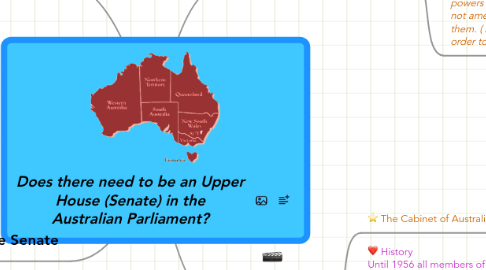Does there need to be an Upper House (Senate) in the Australian Parliament?
作者:ayesha lee


1. Definition
1.1. The Australian Senate is one of the most powerful upper houses of any parliament in the world. With equal representation of the States, a proportional voting system that allows minority parties to win seats, the Senate is rarely controlled by the Government or the Opposition.
2. Parties in the Senate
2.1. Liberal Party Of Australia
2.1.1. New node
2.2. Australian Labor Party
2.3. National Party Of Australia
2.4. Australians Green
2.5. Family First Party
2.6. Democratic Labor Party
3. Function of the Senate
3.1. To pass law or legislation
3.2. Any Senator or Member may introduce a proposed law (a bill), except for a money bill (a bill proposing an expenditure or levying a tax), which must be introduced in the House of Representatives
3.3. The Senate has the same legislative powers as the House, except that it may not amend money bills, only pass or reject them. ( All bills must pass BOTH houses in order to become a law )
4. Cabinet
4.1. The Cabinet of Australia is the council of senior ministers of the Crown, responsible to parliament. The Cabinet is appointed by the Governor-General, on the advice of the Prime Minister, and serves at the former's pleasure. The strictly private Cabinet meetings occur once a week to discuss vital issues and formulate policy. Outside of the cabinet there are a number of junior ministers, responsible for a specific policy area and reporting directly to any senior Cabinet minister.
4.2. History Until 1956 all members of the ministry were members of the Cabinet. The growth of the ministry in the 1940s and 1950s made this increasingly impractical, and in 1956 Liberal Prime Minister Robert Menzies created a two-tier ministry, with only senior ministers holding Cabinet rank. This practice has been continued by all governments since, except the Whitlam Government.
4.2.1. INS to insert (Windows)
4.2.2. TAB to insert (Mac OS)
4.2.3. ENTER to add siblings
4.2.4. DEL to delete
4.2.5. All key shortcuts
